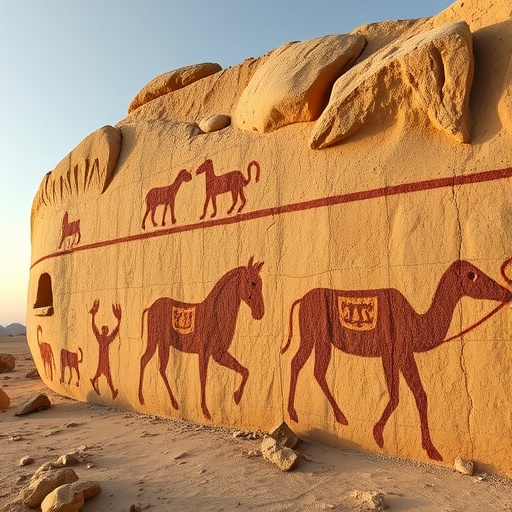A groundbreaking study recently published in Nature Communications unveils monumental rock art that dramatically reshapes our understanding of human resilience and adaptation during the Pleistocene-Holocene transition in the Arabian Desert. This remarkable discovery not only challenges prevailing narratives about the inhospitability of arid landscapes during this critical period but also offers profound insights into the cultural and environmental dynamics of prehistoric human populations in one of Earth’s most formidable deserts.
The Pleistocene-Holocene transition, spanning roughly 12,000 years ago, marks a profound climatic and ecological shift globally, with many regions experiencing significant environmental fluctuations. Traditionally, the Arabian Desert—characterized by extreme aridity and harsh climatic conditions—was considered a barrier to sustained human habitation during this epoch. However, the recent analysis of the rock art sites presents compelling evidence that humans not only inhabited this region but thrived here, utilizing intricate cultural expressions that underscore their adaptive ingenuity.
At the heart of this study are vast panels of rock art, featuring an array of monumental depictions that include enigmatic animal figures and complex symbolic motifs. The grandeur and scale of these engravings defy the previously held assumption that the Arabian Peninsula served merely as a migration corridor or occasional refuge during harsh climatic episodes. Instead, these artworks suggest a stable and vibrant community capable of producing sophisticated visual narratives, which likely played a crucial role in social cohesion and territorial identity.
Technologically, the rock art showcases a diverse range of engraving techniques indicative of skilled artisanship and prolonged artistic traditions. The researchers utilized state-of-the-art dating methods, including optically stimulated luminescence (OSL) and radiocarbon analysis, to precisely establish the chronology of these artworks. These analyses tie the creation of the motifs directly to the Pleistocene-Holocene boundary, pinpointing a period when humans were undergoing dramatic shifts in social organization and environmental interactions.
One of the most striking findings is the depiction of now-extinct megafauna, including large herbivores that thrived in the region’s wetter phases. These images not only provide a direct window into the palaeoecology of the Arabian landscape but also imply that prehistoric communities maintained deep ecological knowledge critical for survival amid fluctuating resource availabilities. This interrelationship between humans and their environment is pivotal in understanding how cultures developed resilience strategies in the face of climate change.
Furthermore, the motifs transcend mere representational art and hint at symbolic and perhaps ritualistic dimensions within these ancient societies. The repetitive nature of certain designs, spatial organization of the sites, and the selection of particular rock surfaces for engraving indicate an intentionality that surpasses functionality. This symbolic behavior is integral to cognitive anthropology, illuminating early human capacities for abstract thought, spirituality, and communication.
Environmental reconstructions derived from sediment cores and paleoclimate data corroborate the interpretation that the Arabian Desert experienced episodic humid intervals during the transition, facilitating biodiversity expansions. These wet phases would have created ephemeral lakes, grasslands, and corridors conducive to both human settlement and faunal migrations. The rock art serves as a cultural marker of these environmental oscillations, capturing a narrative of survival etched into solid rock.
The implications of this discovery ripple across multiple disciplines. Archaeologists are prompted to re-examine models of human dispersal out of Africa, considering the Arabian Peninsula not merely as a passage but as a cradle of cultural innovation. Paleoecologists gain an enriched dataset to reconstruct ecosystem dynamics in a period marked by global climatic instability. Meanwhile, anthropologists glean nuanced perspectives on the evolution of social complexity and symbolic behavior at the dawn of the Holocene.
Importantly, the monumental character of the rock art challenges the prevailing paradigm that early desert dwellers were largely nomadic and transitory. Instead, the scale and permanence of these artworks suggest sedentism or at least recurrent occupation with established territorial claims. This finding encourages a reevaluation of social structures, resource management strategies, and technological adaptations that underpinned human endurance in arid environments.
The international research team composed of experts in archaeology, geology, paleoanthropology, and cultural heritage preservation undertook meticulous fieldwork under challenging desert conditions. Their interdisciplinary approach combined remote sensing, geochemical analysis, and ethnographic parallels to decode the meanings embedded in these silent stone narratives. This multifaceted methodology exemplifies modern archaeological praxis, integrating diverse data streams to reconstruct comprehensive historical accounts.
As climate models predict increasing desertification and environmental stress globally, this ancient record provides valuable insights into past human-environment interactions that may inform present-day strategies for resilience and sustainability. The Arabian rock art stands as a timeless testament to humanity’s capacity to innovate culturally in response to environmental constraints, underscoring the importance of preserving such irreplaceable heritage.
Looking ahead, the study opens fertile ground for further research. Archaeologists anticipate that similar rock art sites might exist undiscovered across the desert, potentially forming a network of cultural landmarks that mapped social landscapes in prehistory. Moreover, advancing dating techniques and drone-assisted surveys promise to accelerate site discovery and contextual understanding, enhancing our grasp of prehistoric human lifeways.
In conclusion, the monumental rock art discovered in the Arabian Desert during the Pleistocene-Holocene transition fundamentally enriches our understanding of early human adaptation, cultural complexity, and ecological interactions in one of Earth’s most challenging habitats. These ancient engravings are not merely artistic relics; they are enduring records of human tenacity, creativity, and deep-rooted connections to landscape—a narrative carved in stone that resonates powerfully across millennia.
Subject of Research: Human adaptation and cultural expression during the Pleistocene-Holocene transition in the Arabian Desert.
Article Title: Monumental rock art illustrates that humans thrived in the Arabian Desert during the Pleistocene-Holocene transition.
Article References:
Guagnin, M., Shipton, C., Al-Jibreen, F. et al. Monumental rock art illustrates that humans thrived in the Arabian Desert during the Pleistocene-Holocene transition. Nat Commun 16, 8249 (2025). https://doi.org/10.1038/s41467-025-63417-y
Image Credits: AI Generated




